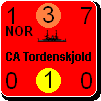Shannon V. OKeets
Posts: 22095
Joined: 5/19/2005
From: Honolulu, Hawaii
Status: offline

|
quote:
ORIGINAL: Froonp
quote:
ORIGINAL: Shannon V. OKeets
quote:
ORIGINAL: sajbalk
Land unit descriptions are difficult -- are we to assume that the unit's designation is actually the divisional one? For example the US 1st corps has a red "1" which probably refers to the 1st division.
Sorry, I never directly answered your question. I believe the 1 refers to 1st Corps. The other unit designations should be for the corresponding sized unit.
On the counter, the "1" means it is the 1s US INF Corps.
But, the fact that it is bold and red, tells me that the designers have wanted to refer to the 1st US INF DIV, also called the Big Red One, in reference for its insign which was a Big Red "1".
That's why I think it is close to impossible to give writeups for the Land Units, because, first, famous WWII land units are division sized, quite never Corps sized, and second, because I believe that Corps composition changed through the war, that is, the Big Red One was not part of the same Corps for all the war. The later is only a general assumption, as I know nothing of WWII real Corps assignements of the Big Red One.
I am not so pessimisstic about this task. Most land units in WIF have 'names', though most often they are numbers and/or letters of some kind. When the designers (ADG) gave the unit a 'name' and assigned numeric values to its ability to move and fight, they were basing that on some historical unit. True, the composition of the unit may have changed during the war. I expect that most of them did. But that doesn't prevent us from doing a writeup on the unit.
If nothing else we could say things like:
"The corps originally was composed of the following divisions ... "
"When it fought in xxx it had division Y replaced by division Z."
"Just before the battle of ABC it was reinforced by division R."
"The most famous division within Corps Z was division S which remained a part of the corps throughout the war."
"As it pushed farther into enemy territory, division L was on the left, division C was in the center, division R was on the right, and division M was in a mobile reserve."
I have only lightly touched upon some possibilities here. There is a lot that can be discussed either in terms of the corps/army/army group itself, or by referring to the elements that made up the large formation.
_____________________________
Steve
Perfection is an elusive goal.
|
 Printable Version
Printable Version





























 New Messages
New Messages No New Messages
No New Messages Hot Topic w/ New Messages
Hot Topic w/ New Messages Hot Topic w/o New Messages
Hot Topic w/o New Messages Locked w/ New Messages
Locked w/ New Messages Locked w/o New Messages
Locked w/o New Messages Post New Thread
Post New Thread